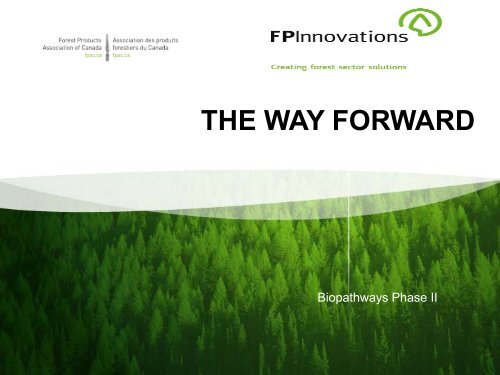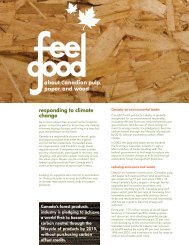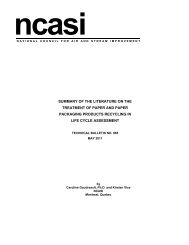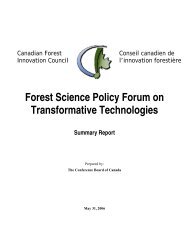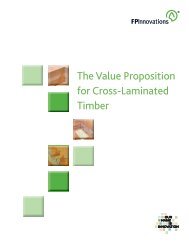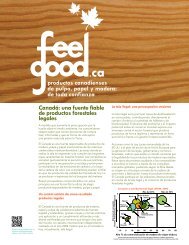The Way Forward - Forest Products Association of Canada
The Way Forward - Forest Products Association of Canada
The Way Forward - Forest Products Association of Canada
Create successful ePaper yourself
Turn your PDF publications into a flip-book with our unique Google optimized e-Paper software.
Title:<br />
THE WAY FORWARD<br />
Biopathways Phase II<br />
1
<strong>The</strong> <strong>Way</strong> <strong>Forward</strong><br />
Source: myamazingfact.blogspot.com<br />
2
Objectives <strong>of</strong> Bio-pathways Project<br />
• Support the industry in identifying possible<br />
transformational strategies<br />
• Create ‘sunrise’ industry vision<br />
• Encourage federal and provincial policy makers to<br />
support transformation<br />
• Provide analytics to investors and partners <strong>of</strong> potential<br />
opportunities<br />
3
What Did We Learn In Phase I<br />
• Economics <strong>of</strong> different bio-product technologies vary<br />
widely depending on site conditions and mill<br />
configurations, location, scale.<br />
• Some <strong>of</strong> the bio-product technologies have much better<br />
returns than conventional production<br />
– ROCE <strong>of</strong> 20%+<br />
• <strong>The</strong> ‘best’ approach integrates conventional and new<br />
technologies (for economics and jobs)<br />
• <strong>The</strong> most promising future involves sawmills and<br />
engineered wood products together with bio-refineries<br />
for production <strong>of</strong> pulp/bio-energy/bio-chemicals<br />
4
PHASE II: OVERVIEW<br />
5
Phase II: What Was Done<br />
• Core teams <strong>of</strong> researchers assigned to:<br />
– Synthesize available information for biomaterials; biochemicals<br />
and bioenergy markets<br />
– Consider business model modifications<br />
– Validate Phase I results with scenarios<br />
– Grow the analysis to cover more technologies and carbon<br />
footprint<br />
– Develop bio-pathways roadmaps for chemical, mechanical pulps<br />
and lumber<br />
• Engaged broad range <strong>of</strong> stakeholders through three<br />
workshops to road test results along the way<br />
6
Phase II Findings: General<br />
• <strong>The</strong> Canadian forest sector is already producing a range<br />
<strong>of</strong> green and low carbon products<br />
• <strong>The</strong>re are great opportunities to increase this contribution<br />
to increase the value for the sector<br />
• This will not replace the traditional forest industry, but will<br />
be an important supplement. Integrating production is<br />
crucial.<br />
• <strong>The</strong>re are many viable options for converting forest<br />
biomass to energy and chemicals<br />
• Phase I results were validated and expanded<br />
See Appendix for summary <strong>of</strong> bioenergy;<br />
biochemical and biomaterial findings<br />
7
<strong>The</strong> Big Picture<br />
GLOBAL MARKET POTENTIALS FOR DIFFERENT BIO-PRODUCTS<br />
FROM FOREST BIOMASS (Billion US$)<br />
Bio-energy, bio-chemicals,<br />
fiber composites<br />
Conventional forest<br />
industrial products<br />
2015 2020 2030<br />
505 776 1309<br />
495 512 545<br />
References:<br />
Heat, power, bio-fuels, bio-gas: FAO, 2010 and IIASA, 2010<br />
Green chemical products: NRCAN and Industry <strong>Canada</strong>, 2010, and Consulting Reports, 2008-2010<br />
Building with wood and living with wood: FPInnovations 2010, and Nilsson & Goodison, 2010<br />
Conventional forest products: FAO, 2008, and Nilsson & Goodison, 2010<br />
8
Gross Market Opportunities<br />
Neg. or 0-2<br />
References:<br />
Markets and Markets. 2009. Global Renewable Chemicals Market.<br />
<strong>The</strong> Freedonia Group. 2009. World Bioplastics. Industry Study 2548.<br />
Lucintel. 2009. Global Glass fibre Market 2010-2015: Supply, Demand and Opportunity Analysis.<br />
Acmite Market Intelligence. 2010. World Carbon fibre Composite Market.<br />
* CAGR for 2010-2015<br />
9
MARKET CHARACTERISTICS<br />
10
Market Size / Price For Co-<strong>Products</strong><br />
•Big volumes – low values<br />
•Low volumes – high values<br />
adapted from Estaban Chornet, November 2005<br />
11
Markets: Additional Findings<br />
Overall: We can not afford to wait – opportunity may pass<br />
us by through aggressive actions <strong>of</strong> others<br />
Bio-Fuels<br />
• <strong>The</strong> large-scale deployment <strong>of</strong> bio-fuels is expected to<br />
happen 2020-2030<br />
• Political policies will play a key role in the size <strong>of</strong> the<br />
deployment<br />
Bio-Chemicals<br />
• Degree <strong>of</strong> hazard in petrochemicals is driving market<br />
toward green chemicals<br />
12
Pulp and Paper Roadmaps<br />
<strong>The</strong>re are three primary paths forward for<br />
the Canadian Pulp and Paper Industry.<br />
Advanced Textiles,<br />
Composites<br />
Canadian Pulp & Paper<br />
Industry<br />
Power / Heat<br />
Refinery:<br />
Transportation Fuels,<br />
Chemicals<br />
13
Wood Roadmaps<br />
<strong>The</strong>re are three primary paths forward for<br />
the Canadian Wood <strong>Products</strong> Industry.<br />
Building with Wood<br />
Canadian Wood <strong>Products</strong><br />
Industry<br />
Living with Wood<br />
Transportation Fuels,<br />
Chemicals<br />
14
BIOPATHWAYS ROADMAPS<br />
BC INTERIOR<br />
15
Top Performing Technologies<br />
Return on Capital Employed<br />
BC Central Interior<br />
Cost <strong>of</strong><br />
Capital = 11%<br />
Note: Electricity sales at $150/MW<br />
16
Pulp and Paper Roadmap – Option 1 Advanced Textiles /<br />
Composites BC Central Interior<br />
Commodity Pulps<br />
Reinforcement<br />
Pulps<br />
S<strong>of</strong>twood Kraft<br />
ROCE = 9.4%<br />
Dissolving Pulp<br />
ROCE = 20.5%<br />
Transportation<br />
Fuels, Chemicals,<br />
etc<br />
Pulp & Paper<br />
BCTMP Pulp 1<br />
ROCE = (7%)<br />
Advanced Textiles<br />
and Composites<br />
Fibre Reinforced<br />
Composites 3<br />
(eg. glass fibre)<br />
Pulp<br />
Notes:<br />
1) BCTMP Pulp roadmaps options not examined<br />
2) Newsprint / LWC<br />
3) Not examined by Bio Pathways<br />
Traditional Papers 2<br />
ROCE = (14%) / 3.4%<br />
Commodity Papers<br />
17
Pulp and Paper Roadmap – Option 2 Power / Heat<br />
Pathways BC Central Interior<br />
Large Scale Co-Gen<br />
ROCE = 5.5 / 10.7% 1,2<br />
Kraft Pulp<br />
(950,000 odt)<br />
ROCE = 9.4%<br />
Large Scale CHP<br />
ROCE = 18.6 / 23.7% 1,3<br />
Pyrolysis 4<br />
ROCE = 13.3%<br />
Power / Heat<br />
Gasification<br />
ROCE = 10.1%<br />
Notes:<br />
1) First ROCE is based on <strong>Forest</strong> Residues / Second is based on Hog Fuel<br />
2) At $150/MW then ROCE = 12.4%<br />
3) At $150/MW then ROCE = 22.8%<br />
4) Draft<br />
18
Pulp and Paper Roadmap – Option 3 Refinery<br />
Pathways BC Central Interior<br />
Gasification<br />
Ethanol / Acetate<br />
ROCE = 11.6% 1<br />
ROCE = 16.3% 2<br />
Pyrolysis<br />
Oil<br />
ROCE = 13.0%<br />
Kraft Pulp<br />
Fermentation<br />
ROCE = -19.9%<br />
Fuel<br />
Refinery /<br />
Chemical<br />
Plant<br />
Transportation<br />
Fuels,<br />
Chemicals<br />
(950,000 odt)<br />
Tall Oil<br />
ROCE = 9.4%<br />
FT Diesel 3<br />
ROCE = 3% / 8%<br />
Lignin<br />
ROCE = 12%<br />
Notes:<br />
1) Ethanol for Blending<br />
2) Acetate to Market<br />
3) Medium / Mega<br />
Full Fractionation ROCE = 8.6%<br />
(Viscose, Ethanol, Furfural, Lignin)<br />
Incremental Chemicals<br />
Chemicals,<br />
Textiles,<br />
Composites<br />
(Methanol, Furfural, Lignin)<br />
19
Building Materials - Wood Roadmap<br />
Fermentation not included due to scale needed.<br />
20
Building Materials - Wood Roadmap with ROCE Results<br />
BC Central Interior<br />
Building with Wood<br />
CLT ROCE = 34.0%<br />
LVL = 18.0%<br />
CLT, EWP,<br />
Commodity<br />
Lumber<br />
Living with Wood<br />
ROCE = 18.0%<br />
Appearance<br />
grade products<br />
Nexterra CHP 2<br />
ROCE = 18.0%<br />
Power<br />
Power / Heat<br />
SPF West<br />
Med 1<br />
ROCE = 15%<br />
Nexterra N.G.<br />
Replacement<br />
ROCE = 15.3%<br />
Pyrolysis 2,3<br />
ROCE = 19.2%<br />
Pyrolysis<br />
ROCE = 21.5%<br />
Gasification<br />
Oil<br />
SynGas<br />
Refinery<br />
ROCE = 13.1%<br />
Power<br />
Transportation<br />
Fuels,<br />
Chemicals<br />
ROCE = 17.7%<br />
Notes:<br />
1) Based on 250 mmfbm facility, hog fuel imported to match scales.<br />
2) Based on $150/MW<br />
3) Draft Results<br />
Incremental Chemicals<br />
21<br />
Chemicals
Bio Pathways Roadmaps<br />
Results for Ontario<br />
22
Top Performing Technologies<br />
Return on Capital Employed<br />
Ontario<br />
Cost <strong>of</strong><br />
Capital = 11%<br />
Note: Contains Feed-In-Tariff estimate for pellets.<br />
23
Pulp and Paper Roadmap – Option 1 Advanced Textiles /<br />
Composites Ontario<br />
Commodity Pulps<br />
Reinforcement<br />
Pulps<br />
Kraft Pulp<br />
ROCE = 12.1%<br />
Dissolving Pulp<br />
ROCE = 20.3%<br />
Transportation<br />
Fuels, Chemicals,<br />
etc<br />
Pulp & Paper<br />
BCTMP Pulp 1<br />
ROCE = (3%)<br />
Advanced Textiles<br />
and Composites<br />
Fibre Reinforced<br />
Composites 3<br />
(eg. glass fibre)<br />
Pulp<br />
Notes:<br />
1) BCTMP Pulp roadmaps options not examined<br />
2) Newsprint / LWC<br />
3) Not examined by Bio Pathways<br />
Traditional Papers 2<br />
ROCE = (9.5%) / 4.7%<br />
Commodity Papers<br />
24
Pulp and Paper Roadmap – Option 2 Power / Heat<br />
Pathways Ontario<br />
Large Scale Co-Gen<br />
ROCE = 6.8 / 13.2% 1<br />
Kraft Pulp<br />
(950,000 odt)<br />
ROCE = 12.1%<br />
Large Scale CHP<br />
ROCE = 18.0 / 24.4% 1<br />
Pyrolysis 2<br />
ROCE = 16.6%<br />
Power / Heat<br />
Gasification<br />
ROCE = 13.6%<br />
Notes:<br />
1) First ROCE is based on <strong>Forest</strong> Residues / Second is based on Hog Fuel<br />
2) Draft<br />
25
Pulp and Paper Roadmap – Option 3 Refinery<br />
Pathways Ontario<br />
Gasification<br />
Ethanol / Acetate<br />
ROCE = 15.1% 1<br />
ROCE = 19.6% 2<br />
Pyrolysis<br />
Oil<br />
ROCE = 16.7%<br />
Kraft Pulp<br />
Fermentation<br />
ROCE = -19.9%<br />
Fuel<br />
Refinery /<br />
Chemical<br />
Plant<br />
Transportation<br />
Fuels,<br />
Chemicals<br />
(950,000 odt)<br />
Tall Oil<br />
ROCE = 12.1%<br />
FT Diesel 3<br />
ROCE = 1% / 5%<br />
Lignin<br />
ROCE = 16.2%<br />
Notes:<br />
1) Ethanol for Blending<br />
2) Acetate to Market<br />
3) Medium / Mega<br />
Full Fractionation ROCE = 10.7%<br />
(Viscose, Ethanol, Furfural, Lignin)<br />
Incremental Chemicals<br />
Chemicals,<br />
Textiles,<br />
Composites<br />
(Methanol, Furfural, Lignin)<br />
26
Building Materials - Wood Roadmap<br />
Fermentation not included due to scale needed.<br />
27
Building Materials - Wood Roadmap with ROCE Results<br />
Ontario<br />
Building with Wood<br />
CLT ROCE = 36.6%<br />
LVL = 20.0%<br />
CLT, EWP,<br />
Commodity<br />
Lumber<br />
Living with Wood<br />
ROCE = 21.0%<br />
Appearance<br />
grade products<br />
Nexterra CHP 1<br />
ROCE = 18.1%<br />
Power<br />
Power / Heat<br />
SPF East<br />
Med 1<br />
ROCE = 17%<br />
Nexterra N.G.<br />
Replacement<br />
ROCE = 17.2%<br />
Pyrolysis 1,2<br />
ROCE = 18.0%<br />
Pyrolysis<br />
ROCE = 23.7%<br />
Gasification 1<br />
Oil<br />
SynGas<br />
Refinery<br />
ROCE = 13.9%<br />
Power<br />
Transportation<br />
Fuels,<br />
Chemicals<br />
ROCE = 18.9%<br />
Incremental Chemicals<br />
Chemicals<br />
Notes:<br />
1) Based on 250 mmfbm facility, hog fuel imported 28to match<br />
scales.<br />
2) Draft Results
Bio Pathways Roadmaps<br />
Results for Quebec<br />
29
Top Performing Technologies<br />
Return on Capital Employed<br />
Quebec<br />
Cost <strong>of</strong><br />
Capital = 11%<br />
30
Pulp and Paper Roadmap – Option 1 Advanced Textiles /<br />
Composites Quebec<br />
Commodity Pulps<br />
Reinforcement<br />
Pulps<br />
Kraft Pulp<br />
ROCE = 12.1%<br />
Dissolving Pulp<br />
ROCE = 20.1%<br />
Transportation<br />
Fuels, Chemicals,<br />
etc<br />
Pulp & Paper<br />
BCTMP Pulp 1<br />
ROCE = (3%)<br />
Advanced Textiles<br />
and Composites<br />
Fibre Reinforced<br />
Composites 3<br />
(eg. glass fibre)<br />
Pulp<br />
Notes:<br />
1) BCTMP Pulp roadmaps options not examined<br />
2) Newsprint / LWC<br />
3) Not examined by Bio Pathways<br />
Traditional Papers 2<br />
ROCE = (9.5%) / 4.7%<br />
Commodity Papers<br />
31
Pulp and Paper Roadmap – Option 2 Power / Heat<br />
Pathways Quebec<br />
Large Scale Co-Gen<br />
ROCE = 6.0 / 13.2% 1<br />
Kraft Pulp<br />
(950,000 odt)<br />
ROCE = 12.1%<br />
Large Scale CHP<br />
ROCE = 17.3 / 24.4% 1<br />
Pyrolysis 2<br />
ROCE = 16.6%<br />
Power / Heat<br />
Gasification<br />
ROCE = 13.6%<br />
Notes:<br />
1) First ROCE is based on <strong>Forest</strong> Residues / Second is based on Hog Fuel<br />
2) Draft<br />
32
Pulp and Paper Roadmap – Option 3 Refinery<br />
Pathways Quebec<br />
Gasification<br />
Ethanol / Acetate<br />
ROCE = 15.1% 1<br />
ROCE = 19.6% 2<br />
Pyrolysis<br />
Oil<br />
ROCE = 16.7%<br />
S<strong>of</strong>twood Kraft Pulp<br />
Fermentation<br />
ROCE = -19.9%<br />
Fuel<br />
Refinery /<br />
Chemical<br />
Plant<br />
Transportation<br />
Fuels,<br />
Chemicals<br />
(950,000 odt)<br />
Tall Oil<br />
ROCE = 12.1%<br />
FT Diesel 3<br />
ROCE = 0% / 5%<br />
Lignin<br />
ROCE = 16.2%<br />
Notes:<br />
1) Ethanol for Blending<br />
2) Acetate to Market<br />
3) Medium / Mega<br />
Full Fractionation ROCE = 10.7%<br />
(Viscose, Ethanol, Furfural, Lignin)<br />
Incremental Chemicals<br />
Chemicals,<br />
Textiles,<br />
Composites<br />
(Methanol, Furfural, Lignin)<br />
33
Building Materials - Wood Roadmap<br />
Fermentation not included due to scale needed.<br />
34
Building Materials - Wood Roadmap with ROCE Results<br />
Quebec<br />
Building with Wood<br />
CLT ROCE = 37.6%<br />
LVL = 21.0%<br />
CLT, EWP,<br />
Commodity<br />
Lumber<br />
Living with Wood<br />
ROCE = 22.6%<br />
Appearance<br />
grade products<br />
Nexterra CHP<br />
ROCE = 18.2%<br />
Power<br />
Power / Heat<br />
SPF West<br />
Med 1<br />
ROCE = 19%<br />
Nexterra N.G.<br />
Replacement<br />
ROCE = 18.7%<br />
Pyrolysis 2<br />
ROCE = 16.4%<br />
Pyrolysis<br />
ROCE = 24.7%<br />
Gasification<br />
Oil<br />
SynGas<br />
Refinery<br />
ROCE = 14.7%<br />
Power<br />
Transportation<br />
Fuels,<br />
Chemicals<br />
ROCE = 19.6%<br />
Notes:<br />
1) Based on 250 mmfbm facility, hog fuel imported to match scales.<br />
2) Draft Results<br />
Incremental Chemicals<br />
35<br />
Chemicals
Provincial Comparisons<br />
36
Pulp and Paper Pathways<br />
Pathway<br />
BC Central<br />
Interior<br />
Ontario<br />
Quebec<br />
S<strong>of</strong>twood Kraft 9.4 12.1 12.1<br />
BC TMP (7) (3) (3)<br />
Dissolving Pulp 20.5 20.3 20.1<br />
LWC 3.4 4.7 4.7<br />
Newsprint (14) (9.5) (9.5)<br />
Large Scale Co-Gen 1 5.5 / 10.7 6.8 / 13.2 6.0 / 13.2<br />
Large Scale CHP 1 18.6 / 23.7 18 / 24.4 17.3 / 24.4<br />
Pyrolysis to Power 13.3 16.6 16.6<br />
Gasification to Power 10.1 13.6 13.6<br />
Pyrolysis Oil 13 16.7 16.7<br />
Fermentation (19.9) (19.9) (19.9)<br />
FT Diesel 2 3 / 8 1 / 5 0 / 5<br />
Lignin 12 16.2 16.2<br />
Full Fractionation 8.6 10.7 10.7<br />
Gasification to Ethanol 11.6 15.1 15.1<br />
Gasification to Acetate 16.3 19.6 19.6<br />
<strong>The</strong> overall impact on<br />
ROCE on pulp and paper<br />
pathways is generally less<br />
than on sawmill as sawmills<br />
save on residual<br />
transportation costs (as they<br />
are the source <strong>of</strong> residuals<br />
in most cases)<br />
Larger scale pathways have<br />
the biggest impacts on the<br />
integrated facility.<br />
Regionally there are small<br />
differences between<br />
pathways with the exception<br />
<strong>of</strong> power applications where<br />
pricing policy impacts the<br />
results.<br />
Note:<br />
1) <strong>Forest</strong> Residuals / Hog 37 Fuel<br />
2) FT Diesel Medium / Mega
Building Materials Pathways<br />
Pathway<br />
BC Central<br />
Interior<br />
Ontario<br />
SPF Medium (West / East / East) 15 17 19<br />
Gasification for Dry Kilns 15.3 17.2 18.7<br />
Cross Laminated Timber 34 36.6 37.6<br />
Laminated Veneer Lumber 18 20 21<br />
Living with Wood 18 21 22.6<br />
Gasification CHP 18 18.1 18.2<br />
Pyrolysis to Power 19.2 18 16.4<br />
Pyrolysis to Oil 21.5 23.7 24.7<br />
Gasification to Ethanol 13.1 13.9 14.7<br />
Gasification to Acetate 17.7 18.9 19.6<br />
Quebec<br />
<strong>The</strong> major swing within the roadmaps between the regions is the relative ranking <strong>of</strong><br />
Pyrolysis to Power in BC, vis-à-vis the ranking <strong>of</strong> Living to Wood in Ontario and Quebec.<br />
Without the energy policies in BC (Carbon Tax, Carbon Credits, and Electricity Pricing) the<br />
relative ranking in the technologies would be the same with Living to Wood moving higher<br />
in the rankings.<br />
38
Provincial Best Bets<br />
BC Central Interior<br />
Pulp and Paper<br />
1. Large Scale CHP<br />
2. Dissolving Pulp<br />
3. Gasification to Acetate<br />
Building Materials<br />
1. CLT<br />
2. Pyrolysis to Oil<br />
3. Pyrolysis to Power<br />
Ontario<br />
Pulp and Paper<br />
1. Large Scale CHP<br />
2. Dissolving Pulp<br />
3. Gasification to Acetate<br />
Building Materials<br />
1. CLT<br />
2. Pyrolysis to Oil<br />
3. Living with Wood<br />
Quebec<br />
Pulp and Paper<br />
1. Large Scale CHP<br />
2. Dissolving Pulp<br />
3. Gasification to<br />
Acetate<br />
Building Materials<br />
1. CLT<br />
2. Pyrolysis to Oil<br />
3. Living with Wood<br />
•For Pulp and Paper pathways as long as the residuals are available for hog fuel prices<br />
Combined Heat and Power applications seem to lead followed by higher value chemical<br />
production like dissolving pulp and acetate.<br />
•For Building Materials the pathway starts with CLT and Pyrolysis to Oil and then<br />
depending on the power policy is either Pyrolysis to Power or moving more production to a<br />
Living with Wood focus.<br />
39
Partial Picture<br />
• <strong>The</strong> vision presented is partial and based on knowledge we<br />
have today<br />
• Many other avenues must be explored<br />
– the development <strong>of</strong> industrial bio-technology for production <strong>of</strong> green<br />
specialty chemicals<br />
– the enzyme sector (highly pr<strong>of</strong>itable), a sub-sector <strong>of</strong> the chemical<br />
sector, using modern bio-technologies in production<br />
– pro-biotic bacteria (instead <strong>of</strong> antibiotics) in hygiene fiber products<br />
– nano-cellulose – from salad dressing to bullet-pro<strong>of</strong> jackets<br />
40
How To Implement<br />
• Increase engagement by industry and governments<br />
• Communicate results and potential<br />
• Explore partnerships<br />
– Different industry sectors<br />
– Governments and agencies<br />
– Academia and research organizations<br />
• Mobilize finances<br />
– partnerships with financial industry and governments<br />
– Investing in <strong>Forest</strong> Industry Transformation (IFIT)<br />
generated overwhelming interest in the industry<br />
• Transfer technologies<br />
• Review institutional responsibilities<br />
41
Overall Conclusions<br />
• Great opportunities exist for the forest industry in Biopathways<br />
• Business as usual will not work; hard work required by<br />
industry, governments, and affiliated sectors<br />
• Its hard to draw clear borders between Bio-pathways<br />
products and value added conventional forest products<br />
• <strong>The</strong>refore, the next step should be a general and broad<br />
value-added concept for the complete forest sector<br />
42
APPENDIX 1<br />
43
Phase II Findings: Bio-Energy<br />
• Integrated CHP production in existing mills is a good first<br />
bioenergy step<br />
• Production <strong>of</strong> heat and power and transportation fuels is<br />
economically viable in bio-refineries where high-value<br />
byproducts are also made, or feedstock is inexpensive<br />
• Synthetic hydro-carbons are economically viable for<br />
production <strong>of</strong> bio-energy<br />
• <strong>The</strong> scale <strong>of</strong> bio-energy deployment depends on biomass<br />
availability.<br />
• <strong>The</strong> domestic market for bio-energy use is not welldeveloped<br />
• <strong>The</strong>re is lack <strong>of</strong> consistent policy framework for largescale<br />
bio-energy demand and supply<br />
44
Findings: Bio-Chemicals and Bio-<strong>Products</strong><br />
• Opportunities exist for developing new cellulose products<br />
• Older, smaller scale pulp-mills can convert to production for biochemicals<br />
niche markets<br />
• High-value bio-chemicals will start with multiple, small-niche markets<br />
and the old mill conversion can be an interim solution until markets<br />
have developed and big efficient mills can be established<br />
• Integrated lignin extraction and NBSK pulp-mills is already an available<br />
alternative for adding revenues to pulp-mills<br />
• Hemi-cellulose streams in the pulp-mills can now produce new<br />
chemicals for niche markets with high prices<br />
• <strong>The</strong>re are many small market applications <strong>of</strong> bio-products, e.g.,<br />
replacement <strong>of</strong> glass or other fibers in fiber-reinforced composites<br />
• Integration <strong>of</strong> bio-refineries with pulp- and saw-mills is essential to<br />
ensure high revenues from small streams<br />
45
Phase II Findings: Bio-Materials (Wood)<br />
• Analysis confirmed integration <strong>of</strong> traditional lumber and panel<br />
productions with new bio-products is key for success <strong>of</strong> both<br />
traditional and new products<br />
• A strong future economic outlook exists for lumber through<br />
innovation, agility, and customer alignment<br />
• Wood products industries have great opportunities with new<br />
building and prefabricated systems<br />
• <strong>The</strong> non-residential construction market is a large-scale opportunity<br />
with the right products and systems<br />
• <strong>The</strong> repair renovation market is huge with right products and<br />
systems<br />
• Ultra-low density insulation and packaging are good possibilities<br />
46
Markets: A Chemical Example<br />
• <strong>The</strong> world’s largest chemical industry is SABIC – Saudi Basic Industries<br />
Corporation<br />
o Expanding in specialty chemicals<br />
o Buying companies in the field <strong>of</strong> poly-carbonate, poly-methane, polyamid,<br />
synthetic rubber, foams, spandex-fibers, etc.<br />
o Targeting products for cars, aeroplanes, boats, textiles, etc.<br />
o Aiming at 20-25% <strong>of</strong> the world market <strong>of</strong> poly-carbonate, ethanol, propylen, and<br />
methanol<br />
• During 2009-2011 some US $ 70 billion will be invested in chemical<br />
production in Saudi Arabia alone<br />
• Doesn’t leave much room for investments in other places – risk <strong>of</strong> overcapacities<br />
47
Pulp and Paper Roadmaps<br />
<strong>The</strong>re are three primary paths forward for<br />
the Canadian Pulp and Paper Industry.<br />
Advanced Textiles,<br />
Composites<br />
Canadian Pulp & Paper<br />
Industry<br />
Power / Heat<br />
Transportation Fuels,<br />
Chemicals<br />
48
Pulp and Paper Roadmap – Option 1<br />
Advanced Textiles / Composites<br />
Commodity Pulps<br />
Reinforcement<br />
Pulps<br />
Kraft Pulp<br />
ROCE = 9.4%<br />
Dissolving Pulp<br />
ROCE = 19.5%<br />
Transportation<br />
Fuels, Chemicals,<br />
etc<br />
Pulp & Paper<br />
BCTMP Pulp 1<br />
ROCE = (7%)<br />
Advanced Textiles<br />
and Composites<br />
Fibre Reinforced<br />
Composites 3<br />
(eg. glass fibre)<br />
Pulp<br />
Notes:<br />
1) BCTMP Pulp roadmaps options not examined<br />
2) Newsprint / LWC<br />
3) Not examined by Bio Pathways<br />
All Data BC Normalized with Power at $150/MWh<br />
Traditional Papers 2<br />
ROCE = (14%) / 3%<br />
Commodity Papers<br />
49
Pulp and Paper Roadmap – Option 2<br />
Power / Heat Pathways<br />
Large Scale Co-Gen<br />
ROCE = 5.5 / 10.7% 1<br />
Kraft Pulp<br />
(950,000 odt)<br />
ROCE = 9.4%<br />
Large Scale CHP<br />
ROCE = 18.6 / 22.8% 1<br />
Pyrolysis 2<br />
ROCE = 13.3%<br />
Power / Heat<br />
Gasification<br />
ROCE = 10.1%<br />
Notes:<br />
1) First ROCE is based on <strong>Forest</strong> Residues / Second is based on Hog Fuel<br />
2) Draft<br />
All Data BC Normalized with Power at $150/MWh<br />
50
Pulp and Paper Roadmap – Option 3<br />
Refinery Pathways<br />
Gasification<br />
Ethanol / Acetate<br />
ROCE = 11.6% 1<br />
ROCE = 16.3% 2<br />
Pyrolysis<br />
Oil<br />
ROCE = 13%<br />
Kraft Pulp<br />
Fermentation<br />
ROCE = -19.9%<br />
Fuel<br />
Refinery /<br />
Chemical<br />
Plant<br />
Transportation<br />
Fuels,<br />
Chemicals<br />
(950,000 odt)<br />
Tall Oil<br />
ROCE = 9.4%<br />
FT Diesel 3<br />
ROCE = 3% / 8%<br />
Lignin<br />
ROCE = 12%<br />
Full Fractionation ROCE = 8.6%<br />
Notes:<br />
1) Ethanol for Blending<br />
2) Acetate to Market<br />
3) Medium / Mega<br />
(Viscose, Ethanol, Furfural, Lignin)<br />
Incremental Chemicals<br />
Chemicals,<br />
Textiles,<br />
Composites<br />
(Methanol, Furfural, Lignin)<br />
51<br />
All Data BC Normalized with Power at $150/MWh
Carbon Footprint Analysis<br />
Source: Carbon Footprint Report, 2010<br />
52
Combined Metrics <strong>of</strong> Pulp and Paper Pathways<br />
Pathway<br />
Advanced<br />
Textiles and<br />
Composites<br />
Power /<br />
Heat<br />
Refinery<br />
Kraft<br />
ROCE GDP ($M) /<br />
100,000 ODT<br />
Employment (FTE)<br />
/ 100,000 ODT<br />
Commodity Pulp 9.4% 20 163 13.8<br />
Dissolving Pulp 19.5% 36 226 23.7<br />
BCTMP (7.4%) 34 284 N/A<br />
Paper<br />
Kraft<br />
Kraft<br />
Newsprint (14%) 36 347 12.3<br />
LWC 3% 35 253 13.1<br />
Large Co-Gen 1 10.7% 24 193 0<br />
Large CHP 1 22.8% 30 193 7.954<br />
Pyrolysis 13.3% 23 166 0<br />
Gasification 10.1% 22 165 0<br />
Gasification - Ethanol 11.6% 22 165 0<br />
Gasification - Acetate 16.3% 25 170 0<br />
Pyrolysis 13.0% 22 165 0<br />
Fermentation (19.9%) 12 180 4.5<br />
FT Diesel (Medium) 3% 20 144 N/A<br />
Lignin 12% 22 165 17.5<br />
Full Fractionation 8.6% 23 130 6.993<br />
Direct CO2e (kt)<br />
/ 100,000 ODT<br />
Notes:<br />
1) ROCE based on hog fuel input.<br />
All Data BC Normalized with Power at $150/MWh<br />
53
Building Materials - Wood Roadmap<br />
Fermentation not included due to scale needed.<br />
54
Building Materials – Example Roadmap<br />
BC Central Interior<br />
Building with Wood<br />
CLT ROCE = 33.9%<br />
LVL = 18.0%<br />
Living with Wood<br />
ROCE = 18.0%<br />
CLT, EWP,<br />
Commodity<br />
Lumber<br />
Appearance<br />
grade products<br />
Nexterra CHP 2<br />
ROCE = 18.0%<br />
Power<br />
Power / Heat<br />
SPF West<br />
Med 1<br />
ROCE = 15%<br />
Nexterra N.G.<br />
Replacement<br />
ROCE = 15.3%<br />
Pyrolysis 2,3<br />
ROCE = 19.2%<br />
Pyrolysis<br />
ROCE = 21.5%<br />
Gasification<br />
Oil<br />
SynGas<br />
Refinery<br />
ROCE = 13.1%<br />
Power<br />
ROCE = 17.7%<br />
Transportation<br />
Fuels,<br />
Chemicals<br />
Notes:<br />
1) Based on 250 mmfbm facility, hog fuel imported to match scales.<br />
2) Based on $150/MW<br />
3) Draft Results<br />
All Data BC Normalized with Power at $150/MWh<br />
Incremental Chemicals<br />
55<br />
Chemicals
Combined Metrics <strong>of</strong> Building Materials<br />
Pathways<br />
Pathway<br />
Building With<br />
Wood<br />
SPF West<br />
Med<br />
ROCE<br />
GDP ($M)<br />
/ 100,000<br />
ODT<br />
Employment<br />
(FTE) /<br />
100,000 ODT<br />
SPF West Med 15% 25 196 9.5<br />
CLT 34% N/A N/A 5.3<br />
LVL Large 18% 48.5 362 6.8<br />
Living with Wood 1 SPF West Med 18% 26 199 9.5<br />
Fuels and<br />
Chemicals<br />
SPF West<br />
Med<br />
N.G Replacement 15.3% 25.1 194 0<br />
Gasification to CHP 18% 28.5 202 0<br />
Pyrolysis to Power 19.2% 31.7 186 0<br />
Pyrolysis to Oil 21.5% 30.4 203 0<br />
Gasification to Ethanol 13.1% 31.7 221 0<br />
Gasification to Acetate 17.7% 33.9 221 0<br />
Direct CO2e<br />
(kt) / 100,000<br />
ODT<br />
Note:<br />
1) Living Direct CO2 emissions per 100,000 odt are assumed to be the same as SPF West Med<br />
All Data BC Normalized with Power at $150/MWh<br />
56
Metrics Summary<br />
Pulp and Paper Pathways (clusters built on Pulp Mill sites):<br />
• On average when a new technology is added to an existing pulp mill site we see an<br />
improvement in ROCE (average 3.7%), and improvement in contribution to GDP (10-<br />
25%) and employment (1-4%). <strong>The</strong> Heat and Power options <strong>of</strong>ten have stronger<br />
social metrics as the scale <strong>of</strong> the plants are larger than some <strong>of</strong> the more pr<strong>of</strong>itable<br />
Fuel and Chemical pathways.<br />
Building Material Pathways (clusters built on Sawmill site):<br />
• New technology options for sawmill improve all the social metrics with the largest<br />
impacts coming from transforming the Building with Wood section. CLT specifically<br />
has a very large impact and the Fuels and Chemicals option also have strong<br />
performance and have the added benefit <strong>of</strong> drawing down the carbon footprint for the<br />
facility.<br />
• <strong>The</strong>re are trade <strong>of</strong>fs in the metrics by shifting from conventional to bio-pathways<br />
production<br />
57
Trade-Offs<br />
58
Building Materials - Wood Roadmap<br />
Building with Wood / Living with Wood<br />
Building with<br />
Wood<br />
Commodity<br />
Customer<br />
Focused<br />
Grades<br />
Panels<br />
Distributor<br />
Systems /<br />
Components<br />
Building<br />
Materials<br />
Industry<br />
Engineered<br />
Wood<br />
<strong>Products</strong><br />
Floors /<br />
Moulding<br />
Prefab<br />
Home Builder / Non<br />
Residential / R&R<br />
Living with<br />
Wood<br />
Doors<br />
Windows<br />
Furniture<br />
59
Home Building Value Chain<br />
35%<br />
Home Building Value Chain<br />
Opearting Margin Analysis (%)<br />
30%<br />
25%<br />
Operating Margin (%)<br />
20%<br />
15%<br />
10%<br />
5%<br />
0%<br />
Timber Building Materials Distributors Components Home Builders<br />
-5%<br />
2009 Five Year Average 2007 Five Year Average 2009 Ten Year Average<br />
60
Home Building Value Chain<br />
35%<br />
Home Building Value Chain<br />
Opearting Margin Analysis (%)<br />
Five Year Average ending in 2007<br />
30%<br />
25%<br />
Operating Margin (%)<br />
20%<br />
15%<br />
10%<br />
5%<br />
0%<br />
Timber Building Materials Distributors Components Home Builders<br />
61
Reviewing Cluster Options<br />
Building with<br />
Wood<br />
Living with<br />
Wood<br />
Wood<br />
Markets<br />
CHP<br />
Power<br />
Heat<br />
Advanced<br />
Composites /<br />
Textiles<br />
Market<br />
Nexterra<br />
Pulp and<br />
Advanced<br />
Fibres<br />
Advanced<br />
Papers,<br />
Packaging<br />
Solid Wood<br />
Industry<br />
Nexterra N.G.<br />
Replacement<br />
Max<br />
Traditional<br />
Energy<br />
Cdn Pulp &<br />
Paper<br />
Industry<br />
Pyrolysis<br />
Tall Oil<br />
Gasification<br />
Fermentation<br />
Refinery<br />
Transportation<br />
Fuels,<br />
Chemicals<br />
Build Economics for each Step<br />
Incremental Chemicals<br />
(Methanol, Furfural,<br />
Lignins)<br />
62
Refinery Capacity<br />
Gasification<br />
Ethanol = 42,000,000 litres or 264,172 barrels or<br />
Refinery Capacity needed: 0.75<br />
Pyrolysis<br />
Fuel Oil = 83,000,000 litres or 523,941 barrels<br />
Refinery Capacity needed: 1.5<br />
<strong>The</strong> capacity <strong>of</strong> existing refineries<br />
would not be significantly<br />
challenged by additional production<br />
<strong>of</strong> ethanol from gasification or oil<br />
from Pyrolysis.<br />
63
Refinery Capacity vis-à-vis Lumber and Paper<br />
Capacity<br />
• Six key regions overlap the Petroleum industry<br />
including<br />
– BC Vancouver (55,000 barrels / day)<br />
– BC Prince George (12,000 barrels / day)<br />
– AB Edmonton (412,000 barrels / day)<br />
– SK Lloydminster (111,000 barrels / day)<br />
– ON Thunder Bay / Sarnia (360,000<br />
barrels / day) – barged from Thunder Bay<br />
– QC Montreal (491,000 barrels / day)<br />
• Key players identified in the Petroleum industry<br />
with overlapping capacity include;<br />
Sawmilling # <strong>of</strong> Facilities Capacity<br />
BC Vancouver 30 1,483,000 mfbm<br />
BC Prince George 11 2,330,000 mfbm<br />
AB Edmonton 14 1,780,000 mfbm<br />
SK Lloydminster 3 127,000 mfbm<br />
ON Thunder Bay 3 (closed 2009)<br />
ON Sarnia 0<br />
Pulp & Paper # <strong>of</strong> Facilities Capacity<br />
BC Vancouver 12 3,500,000 admt<br />
BC Prince<br />
George<br />
15 4,800,000 admt<br />
AB Edmonton 5 1,900,000 admt<br />
SK<br />
Lloydminster<br />
ON Thunder<br />
Bay<br />
1(1) 385,000 admt<br />
3 1,100,000 admt<br />
ON Sarnia 8 1,000,000 admt<br />
64
Refinery Integration – Furthering <strong>The</strong> Pyrolysis<br />
Pathway (1)<br />
• <strong>The</strong> Pyrolysis Pathway has been a strong option for providing fuels and<br />
chemicals. <strong>The</strong>re are technical challenges to overcome but there may<br />
be further synergistic options for the <strong>Forest</strong> and Paper Industry.<br />
• <strong>The</strong> primary issue with using pyrolysis oil in a further refinery pathway is<br />
the high oxygen content in the oil. This problem is being addressed by<br />
hydro-cracking / hydro-processing the pyrolysis oil. This means<br />
hydrogen is added to the oil to make it compatible with heavy oil being<br />
fed into existing refinery operations, an approach being taken by<br />
UOP/Ensyn and the BioCoup program in Europe.<br />
• As a result, Hydrogen capacity is a key to upgrading the pyrolysis oil.<br />
Hydrogen is available from several sources including production from<br />
refineries, electrolysis <strong>of</strong> water, and gasification. One <strong>of</strong> the critical uses<br />
<strong>of</strong> hydrogen is for upgrading non traditional oil such as oil from<br />
Canadian Tar Sands.<br />
• If there is excess hydrogen at an existing refinery, there is a synergistic<br />
fit between upgrading pyrolysis oil at that refinery.<br />
65
Refinery Integration – Furthering <strong>The</strong> Pyrolysis<br />
Pathway (2)<br />
• In the case <strong>of</strong> no hydrogen availability then there are two options<br />
that provide synergistic fits with the forest industry.<br />
– Gasification <strong>of</strong> Biomass<br />
– Hydrogen capture from Sodium Chlorate production<br />
Gasification <strong>of</strong> Biomass:<br />
• Several research institutes including the US DOE are<br />
researching the production <strong>of</strong> hydrogen via gasification. One<br />
goal is to provide a distributed hydrogen production infrastructure<br />
to support future use <strong>of</strong> fuel cells. However technical challenges<br />
remain.<br />
• As the challenges are addressed, there are opportunities for the<br />
existing industry to produce hydrogen<br />
66
Hydrogen Sources – Sodium Chlorate<br />
Hydrogen Capture from Sodium Chlorate:<br />
• Another option that is currently technically available is capture <strong>of</strong> hydrogen from the production <strong>of</strong><br />
sodium chlorate. This is now being done at the sodium chlorate plant in North Vancouver.<br />
• Sodium Chlorate production is primary for the bleaching <strong>of</strong> wood fibre and is closely coupled in<br />
location to the pulp and paper industry.<br />
67
Revised Refinery Cluster based on Sodium Chlorate<br />
- Upgrader at Pulp Mill Site<br />
Unmodified Pyrolysis Oil<br />
Pyrolysis Plant<br />
Sawmill<br />
Unmodified Pyrolysis Oil<br />
Pyrolysis Oil<br />
Upgrader<br />
Pyrolysis Plant<br />
Sawmill<br />
Modified<br />
Pyrolysis Plant<br />
Pyrolysis Oil<br />
Refinery<br />
Refinery<br />
Pulp Mill<br />
Sodium Chlorate<br />
Pyrolysis Oil<br />
Upgrader<br />
Refinery<br />
Refinery<br />
Hydrogen<br />
(Hydrogen Deficient)<br />
(Hydrogen Surplus)<br />
68
Revised Refinery Cluster based on Gassi-fied<br />
Biomass - Upgrader at Sawmill Site<br />
Unmodified Pyrolysis Oil<br />
Pyrolysis Plant<br />
Sawmill<br />
Unmodified Pyrolysis Oil<br />
Pyrolysis Plant<br />
Pyrolysis Oil<br />
Upgrader<br />
Sawmill<br />
Modified<br />
Pyrolysis Plant<br />
Pyrolysis Oil<br />
Refinery<br />
Refinery<br />
Sawmill<br />
Biomass<br />
Pyrolysis Oil<br />
Gasifier<br />
Upgrader<br />
Refinery<br />
Refinery<br />
Hydrogen<br />
(Hydrogen Deficient)<br />
(Hydrogen Surplus)<br />
69
Refinery Integration – Furthering <strong>The</strong> Pyrolysis<br />
Pathway (3)<br />
• Even with technical hurdles for moving down the Fuels and Chemicals<br />
roadmap there are synergistic options with the existing industry;<br />
– in a pulp and paper facility through a hydrogen source such as sodium chlorate<br />
or biomass gasification,<br />
– or in a sawmill through a hydrogen source such as biomass gasification.<br />
• <strong>The</strong> technical hurdles don’t however rule out the pyrolysis pathway as heat<br />
and power options can still be exercised.<br />
• Key to the long term success <strong>of</strong> this roadmap will be partnerships with the<br />
petroleum industry.<br />
70
Calculations for Integrated Bio-pathways<br />
• Pulp and Paper<br />
– Heat and Power (9.4% - 22.8%)<br />
– Refinery Paths (11.6% - 16.3%)<br />
• Building Materials<br />
– Heat and Power (15.3% - 19.2%)<br />
– Refinery Paths (13.1%-21.5%)<br />
– Building Systems (18% - 34%)<br />
• Most <strong>of</strong> the value is from upgrading the value <strong>of</strong> non chip<br />
residuals<br />
71
Ideas for Innovation System<br />
72
Support Program for Bio-pathways<br />
Production (1)<br />
Market and strategic analyses <strong>of</strong> Bio-pathways products<br />
Pulp & Paper<br />
• Transform old mills into bio-refineries<br />
• Develop pathways for chemicals, fuels and polymers from<br />
sugar and lignin<br />
• Develop efficient separation technologies <strong>of</strong> wood into<br />
valuable components<br />
• Develop new composites <strong>of</strong> cellulose materials and<br />
inorganic materials<br />
• Develop nano-technologies for wood fibers<br />
• Improve performance/weight ratio<br />
73
Support Program for Bio-pathways<br />
Production (2)<br />
Market and strategic analyses <strong>of</strong> Bio-pathways<br />
products<br />
Wood <strong>Products</strong><br />
• Investigate technologies from other sectors<br />
• Develop building systems<br />
• Investigate wood properties<br />
• Develop composites<br />
• Increase durability<br />
• Improve performance/weight ratio<br />
74
<strong>The</strong> Complete Industry Value Chain<br />
Source: Agenda 2020 Technology Alliance, 2010<br />
75


